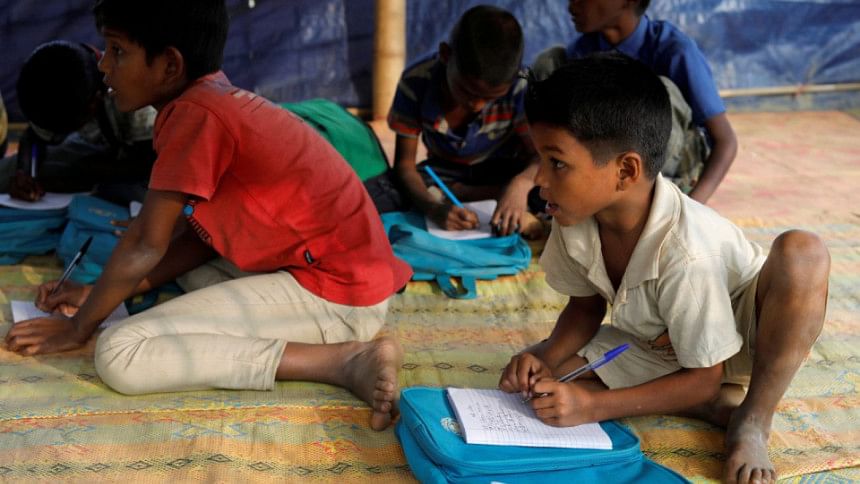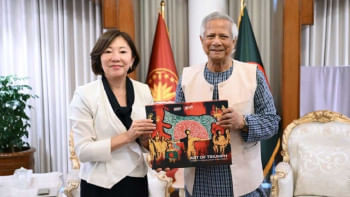Unmaking a 'lost generation'

The dire warning of Unicef about the Rohingya children refugees in the camps in Bangladesh that they may become a "lost generation" warrants urgent and serious attention of the Bangladeshi policymakers and world leaders.
The report titled "Futures in the Balance: Building Hope for a Generation of Rohingya Children" published last week, highlights the plight of at least 381,000 children who are now in various refugee camps in Bangladesh for almost a year. One of the sections of the report is about education, or a lack thereof, of the children which if overlooked can be at the peril of the world. This should not be another report that policymakers, both local and international, gloss over and then forget about.
When I made a brief visit to one of the largest Rohingya refugee camps, in Kutupalong, in early July to get a sense of the children's educational opportunities, it became obvious that whatever is being offered is inadequate. There were a few issues that drew my attention. Some of these were emphasised in the Unicef report while others were not mentioned.
Despite the sincere efforts of the international organisations, including Unicef, it was obvious that the number of educational institutions was insufficient, infrastructures were unsatisfactory, and no specific curriculum was followed. Several refugees and a chairman of the Camp Management Committee stated that these educational institutions were offering non-formal education to the children. Most of these institutions, according to the parents and camp management leaders of the Rohingya community, were providing services to the children only up to the age of 14 owing to resource constraints and a lack of long-term planning. The report mentioned, and the Unicef spokesperson Alastair Lawson-Tancred confirmed in an interview with Reuters (The Guardian, August 22, 2018) that it is the unwillingness of the Bangladesh government that precluded Unicef from establishing educational institutions for children beyond the age of 14. While there is hardly a "mushrooming" of educational centres, as claimed in the report, 1,200 centres were established in one year to serve 381,000 children and Unicef deserves some appreciation. However, these daily two hours of contact "without an agreed and approved curriculum… taught with a variety of materials" are not much of a help to the community. Many camp dwellers were forthright on this point while talking to me.
There was some disappointment among the refugees regarding the absence of any educational opportunity for the younger population, especially for those in the impressionable ages of 15 through 25. This is the cohort that Unicef is now afraid will become the "lost generation." It has already been a year and there is still no agreement on how to address the issue.
At the outset of the Rohingya refugee crisis, many analysts were trying to securitise the entire crisis. They were erroneously suggesting that the ARSA was connected to the transnational terrorist group ISIS, and that these refugees will soon become radicalised. The first point turned out to be wrong. But without wholesale securitisation of the issue, we should be aware that despair and desperation, especially over time, act as proximate causes for some people to take a radical path. There are organisations that target the vulnerable younger population as potential recruits.
I recall that the chairperson I talked to and those who were present during our conversation were quite upset about it. "We neither got the opportunity to educate ourselves nor could acquire any skills in Myanmar, now our next generation isn't getting any of them here either. Even if we ever go back, they will remain at the bottom of the society." I was struck by their emphasis on skills along with the issue of formal education. Neither Unicef's report nor any other available plan explores whether a curriculum with vocational training can be devised to address the situation.
The Bangladesh government's objection to any long-term education plan is due to its fear of whether it will send the wrong message—that the Rohingyas are accepted "permanently". This is understandable, but not having a long-term educational arrangement does not expedite the repatriation process. Besides, if unfortunately the members of the "lost generation" become a security threat, it will be Bangladesh that will bear the brunt of it. Equally important to note is that the international community is failing to live up to its end of the bargain. For example, Unicef's appeal for USD 28.2 billion for education of Rohingya children has not been met—only half has been raised.
During the visit, I also learned that a significant number of religious educational institutions have been founded by various Islamic charity organisations. Although they are referred to as madrasas, most of them are pre-primary institutions, better described as maktabs. A few are equivalent to madrasa. As I visited some of these maktabs, I was told that the number stands at around 830 throughout the Kutupalong camps. My impression was that the number is actually higher than the commonly available account. However, it is also smaller than what some alarmists want us to believe. "Thousands and thousands of madrasas have proliferated inside the camps" seems to me an exaggerated statement. Presumably, these maktabs are not included in Unicef's count of 1,200 learning centres.
These maktabs provide a semblance of order in the lives of the children. These institutions too are only for children aged not more than 12-13 years. Children join these maktabs in the early part of the day, and instructors of these maktabs told me that many of their students also attend the non-formal learning centres, which they described to me as "schools". These maktabs, by definition, are only providing religious education—rudimentary lessons on the Arabic alphabet and rote memorisation of the Qu'ran. Although these institutions have not coordinated their curriculum, they have similarities as they offer education to the same age group.
One of the instructors I met used to teach in a maktab in Rakhine state until 2012. After the violence in 2012, his maktab was shut down by authorities. However, he continued to teach at his home. After he fled to Bangladesh, he became involved with one of the maktabs. Most of these maktabs use the same infrastructure of mosques. There are quite a few that are supported by Hefazat-i-Islam; some are the result of the initiatives of the refugees who view religious education as an integral part of their identity.
The reason that I brought up the issue of these institutions is to suggest that the government and Unicef should explore whether these infrastructure and institutions can be utilised to expand their reach to the children and whether they can be incorporated into the planned Learning Competency Framework and Approach (LCFA). The LCFA, among other things, plans to offer education up to grade 8 employing English, Burmese and other local dialects.
Time is running out and the world should not let a generation be lost.
Ali Riaz is a distinguished professor of political science at the Illinois State University, USA.





Comments